ERA Country Report 2023
Luxembourg
Edited by Matteo Marti (Ecorys)
as part of ‘Development of the ERA Scoreboard, the ERA Dashboard and the Regular Reports’ project for the European Commission, Directorate-General for Research and Innovation under Framework Contract N° 2018/RTD/A2/OP/PP-07001-2018 Lot 2 (EDAR)
Click here to download this country report![]()
- Table of contents
-
ERA Country Report 2023: Luxembourg
1. National context
1.1. Overview of the ERA policy agenda implementation
1.2. Policy context
2. Assessment of the Implementation of the ERA Policy Agenda and ERA Priorities
2.1. ERA Priority 1: Deepening a truly functional internal market for knowledge
2.2. ERA Priority 2: Taking up together the challenges posed by the twin green and digital transition and increasing society’s participation in the ERA
2.3. ERA Priority 3: Amplifying access to research and innovation excellence across the Union
2.4. ERA Priority 4: Advancing concerted research and innovation investments and reforms
3. Country-specific drivers and barriers
4. Final remarks
5. Bibliography
6. Annexes
6.1. Annex 1: Graphs
ERA Country Report 2023: Luxembourg
|
Key takeaways:
|
1. National context
1.1. Overview of the ERA policy agenda implementation
Luxembourg has committed to six ERA Actions under ERA Priority 1 and 2 (Action 1, 5, 7, 9, 10, and 14). Despite a low number of commitments, the country was described as a 'strong innovator’ in the 2023 European Innovation Scoreboard with a performance at 117.2% of the EU average. The Scoreboard highlights key strengths in the country’s attractiveness to foreign doctoral students, a strong collaboration between the public and private sectors, and a high share of tertiary-educated population. However, the same report indicates that the positive performance gap relative to the EU average was narrowing (decrease of 1.5 points for Luxembourg against an increase of 8.5 points in the EU). ^
Despite having a robust public research ecosystem, the stagnation in the R&I sector is tied to a lack of business investments and low government support for business innovation. This is partially due to the absence of indirect support to business R&I in the form of tax credits, unlike most OECD and EU countries. ^ Luxembourg’s current national strategy for R&I is determined by the National Research and Innovation Strategy, which covers the 2020-2030 period. Further details on the strategy are provided in the following section.
1.2. Policy context
Luxembourg's national R&I efforts are spearheaded by two main institutions that operate closely. The Ministry of Higher Education and Research (MESR) in charge of setting the political agenda and overarching strategy, and the Luxembourg National Research Fund (FNR), an autonomous public institution that invests both public funds and private donations into R&I. The partnership is structured through four-year contracts which also determine core research priority areas. ^
The latest national plan for the 2020-2030 period, the National Research and Innovation Strategy, was implemented in 2019 and aims to address challenges uncovered by a 2016 OECD study into the national R&I framework ^ Its mission of research is organised into three actions.
The first element aims for “coordinated governance, infrastructures, and policies”. The country has unified various public research actors under one overarching committee: Research Luxembourg. Under this goal, Luxembourg will also invest in infrastructure and keep supporting European initiatives in line with the ERA priorities (especially Actions 1 and 10). Financially, the government aims to increase public investments in R&I to 1% of the national GDP by 2023. In 2021 the country only invested 0.55% of its GDP in R&I and the EUR 1.7 billion budget for 2022-2025 still falls short of the pledge despite a recent EUR 300 million increase.
Secondly, Luxembourg will introduce a “regulatory framework and funding instruments that allow research to act as a driver for innovation in industry, services, and the public sector” including the creation of new public-private partnerships in coordination with the Ministry of Economy (ME) and Luxinnovation, the national innovation agency. Funding programmes will continue through the FNR.
Thirdly, Luxembourg wants to promote the “anchorage of sciences in society” which aligns well with ERA Action 14 for the inclusion of citizens in science.
As a small country, Luxembourg has chosen to narrow its research environment, which is why the country adopted four priority areas of research that ''clearly define the expected contribution from its (Luxembourg’s) research ecosystem to societal development and maximise the synergies and complementarities between the different actors of research and innovation'. ^ These core interdisciplinary areas include Industrial and Service Transformation, 21st Century Education, Personalised Healthcare, Sustainable and Responsible Development. ^ Projects under these categories are entitled to facilitated public funding schemes, in particular the CORE initiative which is a fund dedicated to these thematic priorities. ^
Beyond public academic research, Luxembourg has taken steps to increase government support for private R&I. For instance, the law for the promotion of business R&I of May 2017 became a key tool in the diversification of the Luxembourgish economy. Additionally, other public institutions such as the Ministry of Economy or the National Society of Credit and Investment (SNCI) regularly assist and fund innovative private initiatives such as the Luxembourg Future Fund (in collaboration with the European Investment Fund and in line with ERA Action 10) or the Luxembourg Cluster Initiative. ^
2. Assessment of the Implementation of the ERA Policy Agenda and ERA Priorities
To assess the country´s implementation of the ERA Policy Agenda, this section provides information on the national strategies gathered from the OECD STIP Survey and additional desk research on Luxembourg´s contribution to the ERA Actions. Furthermore, the section covers the progress regarding the ERA priorities through ERA Scoreboard and ERA Dashboard indicators.
The quantitative information presents the most recent data available for the ERA Scoreboard and ERA Dashboard indicators. However, in some cases, the data available pre-dates the ERA Policy Agenda. Therefore, the longer-term trends covering the last ten years are presented. The indicators falling under each ERA priority are presented below, and the general indicators are outlined in Table 1. More detailed information on the data and graphs can be found in Annex 1. This report will serve as a baseline for reporting in the future.
|
Indicator |
Most recent EU average |
Most Recent Metric |
|
Gross Domestic Expenditure on R&D (GERD) as a percentage of GDP |
2.26 (2021) |
1.02 (2021) |
|
Government Budget Allocations for R&D (GBARD) as a share of GDP |
0.76 (2021) |
0.59 (2021) |
|
Researchers (in full-time equivalent) per million inhabitants |
4,483.4 (2021) |
5,051.0 (2021) |
|
Business Enterprise expenditure on R&D (BERD) as a percentage of GDP |
1.49 (2021) |
0.5 (2021) |
Source: compiled by research team based on the ERA Scoreboard and ERA Dashboard indicators
2.1. ERA Priority 1: Deepening a truly functional internal market for knowledge
2.1.1. State of play in the implementation of the ERA Actions
In relation to ERA Action 1: Enable the open sharing of knowledge and the re-use of research outputs, including through the development of the European Open Science Cloud (EOSC), Luxembourg adopted a National Policy on Open Access in 2015 for all public-sector information, enforced by amending Law of 4 December 2007 on the reuse of public knowledge. ^ In line with this national policy, the FNR requires that all publications since 2017 must be open access, a decision facilitated by the Open Access Fund which covers online publication fees. ^
The FNR’s Research Data Management (RDM) Policy is aligned with the core requirements for RDM as defined by the Science Europe practical guide to the international alignment of RDM. ^ As compiled under the EOSC 2021 Survey, the new FNR Policy on Research Data Management becomes a crucial policy for EOSC (European Open Science Cloud). ^ This initiative covers how to organise, structure, store, and care for research data used or generated during the lifetime and after completion of a research project. The University of Luxembourg also hosts the Centre for Contemporary and Digital History which further analyses and disseminates national and EU history.
ERA Action 5 aims to promote gender equality and foster inclusiveness and Luxembourg has implemented a range of policies and legal tools to address gender imbalance in R&I. For instance, all public research centres are required to have gender balance on their Board of Directors and Scientific Advisory Boards. ^ ^
Since the founding of the University of Luxembourg, a Delegate for Women's Questions assists the Rectorate in all matters regarding gender equality. ^ The University also has a Gender Equality Officer presiding over the Gender Equality Committee in charge of the creation, revision, and implementation of a yearly Gender Equality Plan (GEP).
Luxembourg also has a ministry dedicated to gender equality: the Ministry of Equality between Men and Women (MEGA). The integration of gender in R&I at the University of Luxembourg was included in MEGA's action plan for 2006-2009 and 2009-2014 but was not implemented by the University until 2015. ^ Most recently, the University has drafted a strategy devoted to gender inclusiveness: the 2021 Gender Equality Policy.
Luxembourg is also committed to ERA Action 7 which aims to upgrade EU guidance for a better knowledge valorisation. For instance, the FNR’s JUMP programme aims to bridge the gap between research-driven discoveries and their commercialisation. ^ In line with this action, the University of Luxembourg created a specific programme to stimulate and promote the knowledge of Social Science and Humanities projects with high potential for societal impact in collaboration with its Partnership, Knowledge, and Technology Transfer Office. ^ The University’s Interdisciplinary Centre for Security, Reliability and Trust (SnT) also has a team in charge of commercialising the intellectual property of its researchers.
Regarding ERA Action 9: Promote a positive environment and level playing field based on reciprocity, the Luxembourg National Data Service was founded in 2022 and aims to enable the creation of value from public sector data at the national and international level.
Although Luxembourg did not commit to other actions within Priority Area 1, it has still taken some steps to further open its R&I sector to the European and international level. For instance, the FNR’s INTER funding mechanism aims to foster international cooperation. ^ Other FNR tools to attract foreign talent include the PEARL, AFR-PPP, and ATTRACT programmes. ^
2.1.2. Progress towards achieving ERA Priorities
Regarding Sub-priority 1.1 on Open science, the country is shifting to a more open-access research ecosystem at a faster rate than the European average. It increased its share of publications available in open access from 31.59% to 41.99% between 2009 and 2019, while the EU-27 average only increased by 6 points to reach 39.17% in that period (Figure 5 in Annex 1). For Sub-priority 1.2: Research Infrastructures, Luxembourg has been performing below EU average. In 2021, the country participated (financially contributed) to 4 European research infrastructure projects in contrast to an EU-27 average of 15.46 (Figure 6 in Annex 1).
Sub-priority 1.3 on Gender equality, equal opportunities for all and inclusiveness is measured by several indicators. The national share of women in Grade A positions in Higher Education Institutions (HEIs) was below the European mean between 2010 and 2018 (Figure 7 in Annex). The country’s performance had been stagnating, while the EU-27 increased its share to reach 27.2% (10 points higher than Luxembourg) within the same period. Similarly, the share of women doctoral positions in Sciences, Technology, Engineering and Mathematics (STEM) was also below the European average which has remained constant around 38% for the 2013-2020 period. The national average has fluctuated between 14.63% and 33.01% (Figure 8 in Annex 1).
Another criterion to assess gender inclusiveness is female authorship. Figure 9 in Annex 1 demonstrates the proportion of mixed gender authorship for which Luxembourg has experienced an upwards trend averaging around half of all its publications between 2010 and 2020. However, this remains below the EU-27 trend which was continuously 10 points higher, reaching 62.7% in 2020. Regarding the share of women in the authorships of the 10% most cited publications (Figure 10 in Annex 1), the value had been increasing at a similar rate than for mixed gender authorships but also figures below the European average. Finally, the Women in Digital Index in 2022 highlighted a higher result than the EU-27: 64.6 against 54.9 (Figure 11 in Annex 1).
Luxembourg’s progress towards Sub-priority 1.4 on Researchers’ careers and system is above the European average. In 2021, 89% of all doctorate students were of foreign origin compared to 23% for the EU-27 mean. This value has remained stable in recent years compared to the slight increase observed for Europe (Figure 12 in Annex 1).
Regarding Luxembourg’s number of new doctorate graduates (25-34) per 1,000 inhabitants, the trend is positive, doubling its value between 2013 and 2021 (from less than 0.5 students to 1). In contrast, the European average had been decreasing (Figure 13 in Annex 1). Luxembourg also performed higher than the EU-27 when it comes to job-to-job mobility of human resources in science and technology for which the country stays about two points ahead between 2010 and 2020 (Figure 14 in Annex 1).
Sub-priority 1.5 on Knowledge valorisation is constituted of four indicators. Firstly, Luxembourg's public-private co-publications per million population has accelerated in recent years going from 170 to 537 between 2011 and 2021, a much larger increase than the European average from 86 co-publications to 133 in the same period (Figure 15 in Annex 1).
Regarding PCT applications divided by GDP, Luxembourg performed lower than the EU-27 and observed a slight drop in performance between 2010 and 2013 (Figure 16 in Annex 1). The indicator relating to business enterprise researchers in FTE (Full Time Equivalent) per 1,000 employees in industry shows that Luxembourg's performance had been consistently decreasing in contrast to the EU-27’s steady increase in the previous decade (Figure 17 in Annex 1). The share of innovating firms collaborating with HEIs, and public/private research institutions was constant and hovering around 10% which was slightly under the EU-27 mean for the 2010 to 2020 period (Figure 18 in Annex 1). Lastly, the Luxembourgish share of innovating firms with higher education institutions or public/private research institutions had been very similar to the European average, albeit slightly lower in that same period (Figure 19 in Annex 1).
For Sub-priority 1.6 relating to Scientific leadership, the Grand Duchy was performing similarly to the European average, albeit a few points higher for both the Academic Freedom Index and the number of scientific publications among the top 10% of most cited publications worldwide as percentage of all publications. The trend for both indicators has remained constant mirroring the EU-27 progress between 2010 and 2020 (Figure 20 in Annex 1). Additionally, Luxembourg’s Academic Freedom Index was constant in the last decade and performed slightly higher than the European average (Figure 21 in Annex 1).
Luxembourgish progress towards Sub-priority 1.7 on Global engagement varies significantly depending on the indicator. For the number of international co-publications with non-EU partners, there was a significant increase since 2010, and the Luxembourgish value was three times higher than the EU-27 mean in 2022 (Figure 22 in Annex 1). The data for international co-patenting in European Patent Office (EPO) applications at national and EU level is only available for three years (2010-2013) but shows that Luxembourg was five times less proficient than the European average (Figure 23 in Annex 1).
2.2. ERA Priority 2: Taking up together the challenges posed by the twin green and digital transition, and increasing society’s participation in the ERA
2.2.1. State of play in the implementation of the ERA Actions
Luxembourg has committed towards ERA Action 10: Make EU R&I missions and partnerships key contributors to the ERA and is invested in a range of European research projects. Horizon 2020 was a springboard for the country and partnership participation in the programme was mainly used to build up collaborative networks. Luxembourg participated in 21 of all public H2020 partnerships amounting to EUR 9.47 million in contributions. ^
ERA Action 14, which aims to Bring science closer to citizens, has been addressed as a national priority in the recent National Research and Innovation Strategy. The FNR organises programmes to promote a knowledge-based society through events, training and more. For instance, science.lu, is an interactive website that introduces the public to the scientific world. It showcases national scientific progress and discoveries, offers interactive experiments to introduce science to children, and includes other tools and activities to promote science at home and in schools. The FNR, MESR, Ministry of Education, Childhood and Youth (MENEJ), and the University of Luxembourg all fund different initiatives from the SciTeach Centre, a project dedicated to giving primary school teachers innovative tools and approaches to engage young children in science. Finally, the country is planning for future technologies and is on the path to have an AI Ethics Committee when it assembled a group of legal experts on data and technology to evaluate the finalists of the AI4Gov call for projects.
In addition to its formal commitments towards Priority Area 2, Luxembourg has also created a national innovation agency, Luxinnovation, that funds and operates innovation clusters to boost existing economic fields and promote new synergies. These innovative projects aim to accelerate the green/digital transition in industrial sectors. For instance, in the automotive industry, the country has opened a dedicated research centre focused on next generation mobility solutions (green, connected & automated): the Luxembourg Automobility Cluster.
2.2.2. Progress towards achieving ERA Priorities
To track the progress towards Sub-priority 2.1: Challenge-based ERA actions, the indicator for Government Budget Allocations for R&D (GBARD) by NABS in energy; environment; transport, and telecommunications and other infrastructure between 2010 to 2021 is used. Luxembourg performed significantly below the EU-27 average in all three categories with almost no R&I budget. At the beginning of the decade there was a slight increase of budget in the environment sector, but this value has since dropped to almost zero (Figure 24 in Annex 1). In 2020, the country invested almost double the amount of the EU-27 mean.
Figure 25 (In Annex 1) represents the R&I investments (transnational cooperation) as the GBARD allocated to Europewide transnational, bilateral or multilateral, public R&D programmes per FTE researcher in the public sector and highlights that increased its performance rapidly and overtook the European average which has stagnated within the same period.
For environmentally related government R&D budget as percentage of total government R&D, Luxembourg fluctuated around the EU-27 average between 2% and 4%, but overall has experienced a slight downturn since 2010 (Figure 26 in Annex 1). The data in Figure 27 (Annex 1) is the national public and private investments and indicates that Luxembourg was performing at a steady pace, although lower than the European average. In 2020, the EU-27 average dropped slightly, while Luxembourg dropped from 74.4 to 42.8. Regarding the number of OECD patents on environment technologies, both the Grand Duchy and the EU-27 mean have experienced a downward trend in recent years, but Luxembourg’s drop was more pronounced. In 2019, the country registered an average of 10.22 patents compared to a high of 18.25 in 2011 (Figure 28 in Annex 1).
For Sub-priority 2.2: Synergies with education and the European Skills Agenda, the share of researchers receiving transferable skills training highlights that Luxembourg used to perform higher than the European average in 2016 (65.5% vs 49.5%) but its performance was halved in three years to reach 32.7%, hence falling below the EU-27 average of 46.3% in 2019 (Figure 29 in Annex 1).
Luxembourg’s progress towards Sub-priority 2.3: Synergies with sectorial policies and industrial policy, in order to boost innovation ecosystems is measured through direct government support and indirect government support through R&D tax incentives as a percentage of GDP. The indicator illustrates that Luxembourg performed below EU-27 average for years and experienced a slight downturn since 2017 while the European average had been increasing (Figure 30 in Annex 1).
Regarding Sub-priority 2.4: An active citizen and societal engagement in R&I in all its dimensions the citizen trust in science was measured in 2021 and revealed that trust was lower in the Luxembourg than the EU-27 mean as seen in Figure 31 in Annex 1 (31.6% vs 43.2%). The indicator for the number of publications on “social innovation” or “social entrepreneurship” per million population indicates that Luxembourg observed an increase in publications between 2014 and 2021, but this number remained low with the highest average of 3.38 publications in 2017. This low proportion of publications is also found in the EU-27 as its average never exceeded 2 in the last 10 years (Figure 32 in Annex 1).
2.3. ERA Priority 3: Amplifying access to research and innovation excellence across the Union
2.3.1. Progress towards achieving ERA Priorities
In relation to Sub-priority 3.1: More investments and reforms in countries and regions with lower R&I performance, Luxembourg’s average increase (in percentage points) of total R&D expenditure expressed as a percentage of GDP was negative, only growing slightly between 2013 and 2016. The country experienced its biggest drop in 2012 with -0.21 points. In comparison, the EU-27 average had been positive for ten years and only shrank in 2021 when it dropped to –0.06 (Figure 33 in Annex 1).
2.4. ERA Priority 4: Advancing concerted research and innovation investments and reforms
2.4.1. State of play in the implementation of the ERA Actions
Luxembourg has not committed to any of the ERA Actions under this priority area, although the country has taken some steps to streamline the national research landscape. The new National Research and Innovation Strategy places the need to coordinate governance and policies throughout the country and created a Steering Committee to meet this challenge. Furthermore, the country also aims to centralise R&I public sector initiatives by merging some of its research centres. For instance, the Virtual Centre for Knowledge on Europe (CVEC), was incorporated into the University of Luxembourg.
2.4.2. Progress towards achieving ERA Priorities
Luxembourg’s progress towards Sub-priority 4.1: Coordination of R&I investments is under the European average. The share of public R&D expenditures financed by the private sector remained 5 points below the EU-27 mean between 2010 and 2020. After an increase in 2011 up to 3.65 points, Luxembourg experienced a downward trend with a low point of 1.14% in 2016. Since then, the country performed slightly better and most recently stood at 2.21% (Figure 34 in Annex 1).
3. Country-specific drivers and barriers
Luxembourg has been taking steps to address some of its biggest barriers and better align with ERA Actions. The National Research and Innovation Strategy prioritises key challenges highlighted in the 2016 OECD study in the state of the Luxembourgish R&I ecosystem. Firstly, Luxembourg’s R&I sector is planning to improve its governance and enhance horizontal decision-making to include all research actors. Then, the country wants to advantage tools that would foster innovation in the industry, services, and public sector. Thirdly, the Grand Duchy aims to further include its citizens in the sciences and into the wider R&I sector. ^
The growth of the Luxembourg’s R&I system, strengthens the position of the country at the international level, promoting engagement and leadership in Europe. Among its main assets, Luxembourg is highly appealing research ecosystem to foreign talent ^ encouraging academic excellence, scientific leadership and promotes engagement within R&I. Both the development of research and innovation programmes, and the attractiveness of the research sectors, is facilitated by high incomes. ^ Indeed, Luxembourg has the highest average income out of all EU-27 countries, which positively impacts on researchers’ salaries. ^ ^
Despite the country’s highly skilled worker economy, the international interest on the country´s research system has created dependence on foreign talent. ^ National talent has been decreasing and, currently, Luxembourg lacks new graduates in STEM. ^ Hence, there is a widening skills gap between the national job market and Luxembourgish worker profiles. Similarly, the high level of internationalisation has consequently led to one of the country´s main barriers in relation to ERA: a distinct lack of funding into private R&D initiatives. Neither the public or private sectors are financing R&D initiatives, risking the strong position of Luxembourg in the area. ^ The country also does not provide any indirect support (e.g. tax credits) in contrast to most EU and OECD countries. ^
Therefore, despite many advantages, Luxembourg’s R&D sector is stagnating and is losing its edge relative to the European average. ^ National efforts will be necessary to capitalise on the country’s strengths and address ongoing challenges to ensure the sustainability of the R&I ecosystem in the long-term. As an example, the country is nonetheless taking some actions to boost private R&I. For instance, the Fit 4 performance programme is aimed at start-ups and small and medium-sized enterprises (SMEs) to accelerate funding. ^
4. Final remarks
Luxembourg seeks to “consolidate the achievements of the past” and has chosen to focus on “a limited number of priority areas with a strong socio-economic potential and which contribute to international visibility”. ^ The Grand Duchy has committed to six out of the 17 ERA actions, all within the first two ERA Priorities relating to deepening an internal European market for knowledge and the challenges posed by the twin green and digital transition, including by increasing society’s participation.
Luxembourg is performing well in the open sharing of knowledge by increasing its share of open access publications faster than the EU-27, and in prioritising EU R&I missions and partnerships by increasing its GBARD on transnational, bilateral or multilateral public. Furthermore, Luxembourg R&I sector is very open to internationalisation and the European market of knowledge. Its engagement with the international community in terms of innovation, research and development, has led the country to be highly attractive to European talent.
However, Luxembourg continues to face challenges in relation to some of the ERA Actions it committed towards. Gender inclusiveness is low despite political will to address the challenge (ERA Action 5). Barriers remain in the promotion of science among citizens and the dependence on foreign researchers. Similarly, an incentive programme is needed to increase public and private funding on the R&I sector.
Luxembourg is committed to fostering a positive and rich research ecosystem that is interlinked with international and European actors. Nonetheless, some areas still face important challenges and will require further public support.
5. Bibliography
European Commission (2007). Remuneration of Researchers in the Public and Private sectors.
European Commission (2023). European Innovation Scoreboard 2023 Country Profile Luxembourg. https://ec.europa.eu/assets/rtd/eis/2023/ec_rtd_eis-country-profile-lu.pdf .
European Commission (2023). European Semester 2023 Country Report - Luxembourg. https://economy-finance.ec.europa.eu/system/files/2023-05/LU_SWD_2023_616_en.pdf .
European Commission (2022). H2020 Country Fiche – Luxembourg. https://ec.europa.eu/research-and-innovation/sites/default/files/bmr-2022/ec_rtd_bmr-2022-luxembourg-country-fiche.pdf .
European Insititute for Gender Equality (2023). Gender Equality in Academia and Research - GEAR tool – Luxembourg. https://eige.europa.eu/gender-mainstreaming/toolkits/gear/legislative-policy-backgrounds/luxembourg?language_content_entity=en .
European Investment Fund (2022). Luxembourg Future Fund 1 (LFF). https://www.eif.org/what_we_do/resources/lff/index.htm l.
Eurostat (2023). Wages and Labour Costs. https://ec.europa.eu/eurostat/statistics-explained/index.php?title=Wages_and_labour_costs#Gross_wages.2Fearnings
Gareth O'Neill, & Stefania Martziou. (2022). Data of Survey on National Contributions to EOSC 2021 https://doi.org/10.5281/zenodo.7431678
Innovative Initiatives (2021) AI Ethics Committee. https://innovative-initiatives.public.lu/initiatives/ai-ethics-committee
Law of 12 August 2003 on the creation of the University of Luxembourg (Loi du 12 août 2003 portant création de l’Université du Luxembourg). Journal Officiel du Grand-Duché de Luxembourg.
Law of 17 May 2017 on schemes to promote research, development and innovation (Loi du 17 mai 2017 ayant pour objet 1) le renouvellement des régimes d'aides à la recherche, au développement et à l'innovation; 2) les missions de l'Agence nationale pour la promotion de l'innovation et de la recherche; et modifiant la loi modifiée du 5 juin 2009 relative à la promotion de la recherche, du développement et de l'innovation.)
Law of 23 May 2016 amending Law of 4 December 2007 on the reuse of public sector infromation (Loi du 23 mai 2016 modifiant la loi du 4 décembre 2007 sur la réutilisation des informations du secteur public.). Journal officiel du Grand-Duché de Luxembourg.
Law of 26 February 2016 amending Law of 7 august 2002 on the creation of the Virtual Centre for European Knowledge (Loi du 26 février 2016 abrogeant la loi du 7 août 2002 portant création du Centre Virtuel de la Connaissance sur l’Europe)
Law of 27 August 2014 amending the modified law of 31 May 1999 on the creation of a national fund for research in the public sector (Loi du 27 août 2014 modifiant la loi modifiée du 31 mai 1999 portant création d'un fonds national de la recherche dans le secteur public). Journal officiel du Grand-Duché de Luxembourg.
Law of 3 December 2014 on the organisation of public research centres (Loi du 3 décembre 2014 ayant pour objet l'organisation des centres de recherche publics). Journal officiel du Grand-Duché de Luxembourg.
Luxembourg National Research Fund (2023) Consolidated FNR policy on Open Access to Scientific Publications Version 2023.
Luxembourg National Research Fund (2023). Funding instruments. https://www.fnr.lu/funding-instruments/.
Luxinnovation (2023). Luxembourg Cluster Initiative. https://www.luxinnovation.lu/innovate-in-luxembourg/luxembourg-cluster-initiative/
Luxinnovation & Minister of Economy (2023). Luxembourg Automobility Cluster. https://www.luxinnovation.lu/cluster/luxembourg-automobility-cluster/ .
Ministry of Economy (2023). Lauch of Luxembourg Future Fund 2. https://meco.gouvernement.lu/en/actualites.gouvernement%2Ben%2Bactualites%2Btoutes_actualites%2Bcommuniques%2B2023%2B03-mars%2B17-backes-fayot-launch-ffl.html .
Ministry of Higher Education and Research & Luxembourg National Research Fund (2022). Pluriannual convention 2022-2025. FNR/CP5-22-25.
Ministry of Higher Education and Research (2020). National Research and Innovation Strategy. https://gouvernement.lu/dam-assets/documents/actualites/2020/02-fevrier/25-mesr-strategie-recherche-innovation/mesr-strategy-research-innovation.pdf
OECD (2016), OECD Reviews of Innovation Policy: Luxembourg 2016, OECD Publishing, Paris.
OECD-STIP Survey (2023). Policy debates
University of Luxembourg (2023). Initiation of Programmes and Actions to support the valorisation of Social Sciences and Humanities projects with high potential for societal impact. https://ec.europa.eu/research-and-innovation/sites/default/files/kvp/files/kvp-valorisation-of-ssh.pdf .
Research Luxembourg (2022). Luxembourg to invest 1.7bn euros in research and higher education. https://www.researchluxembourg.org/en/luxembourg-to-invest-1-7bn-euros-in-research-and-higher-education /.
Science.lu (2023) A propos de science.lu. https://science.lu/fr/propos-sciencelu .
University of Luxembourg (2023). Interdisciplinary Centre for Security, Reliability and Trust (SnT). https://www.uni.lu/snt-en/innovation/ .
University of Luxembourg (2023). SciTeach Centre. https://sciteach.uni.lu/en/english-research/ .
6. Annexes
6.1. Annex 1: Graphs
The 2023 ERA Scoreboard and ERA Dashboard indicators used in the country report are presented in this annex. Detailed information on the data sources, description of the indicators, time period for which the data is available, and the necessary calculations can be found in the ERA Scoreboard and ERA Dashboard Methodology Report The latest available data for each indicator has been used.
General Indicators
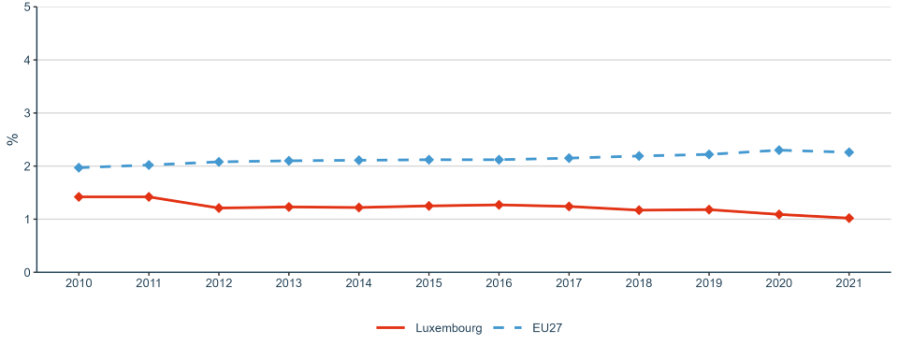
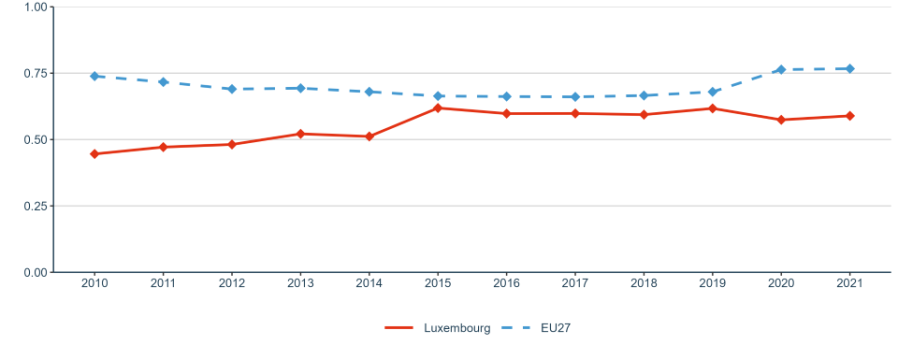
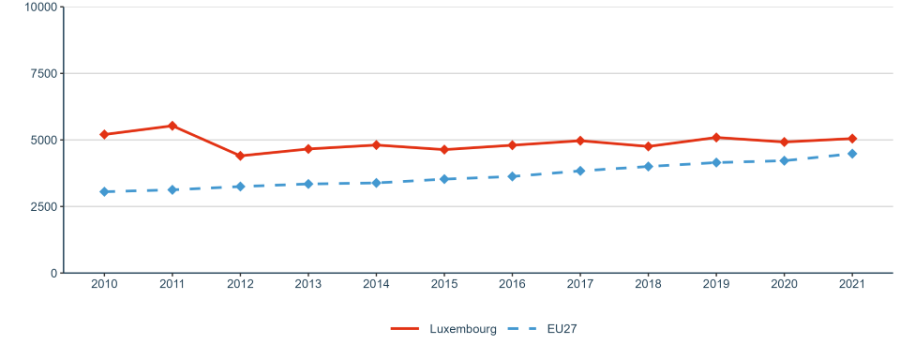
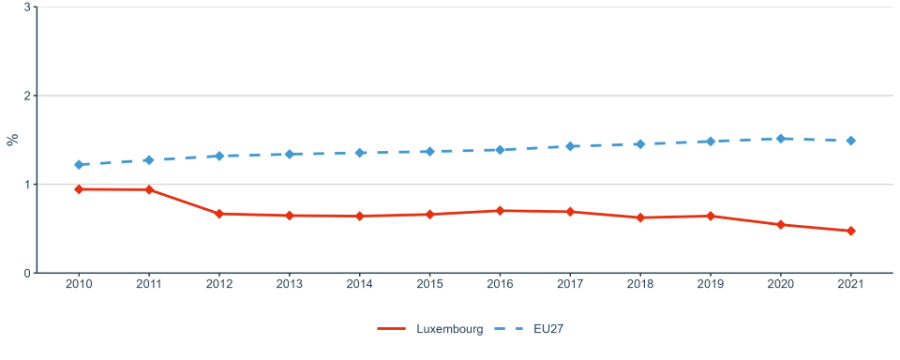
Priority 1: Deepening a truly functioning internal market for knowledge
Sub-priority 1.1: Open Science

Sub-priority 1.2: Research infrastructures
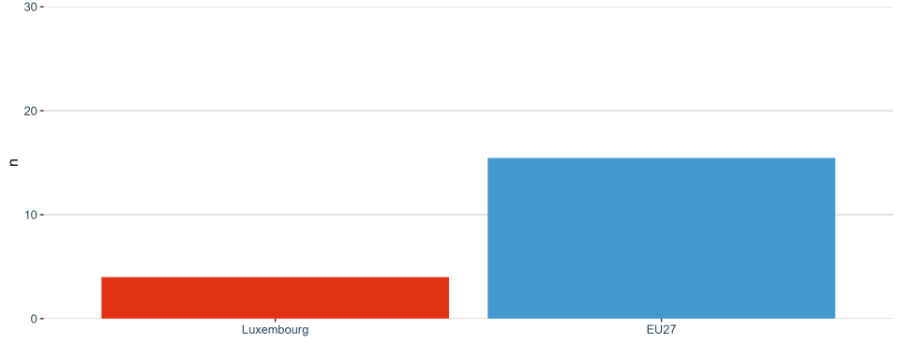
Sub-priority 1.3: Gender equality, equal opportunities for all and inclusiveness
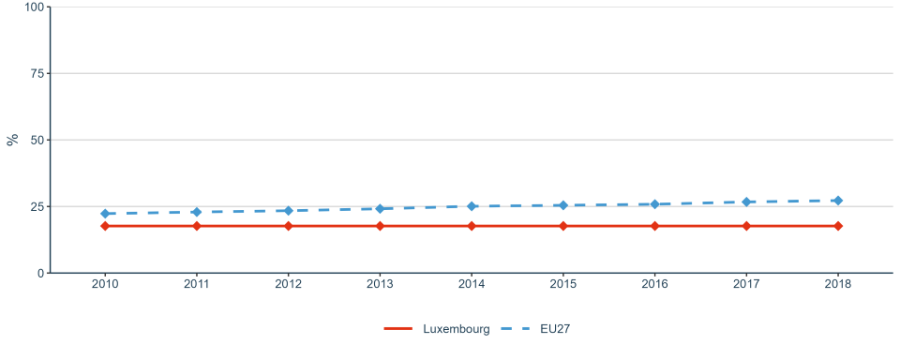
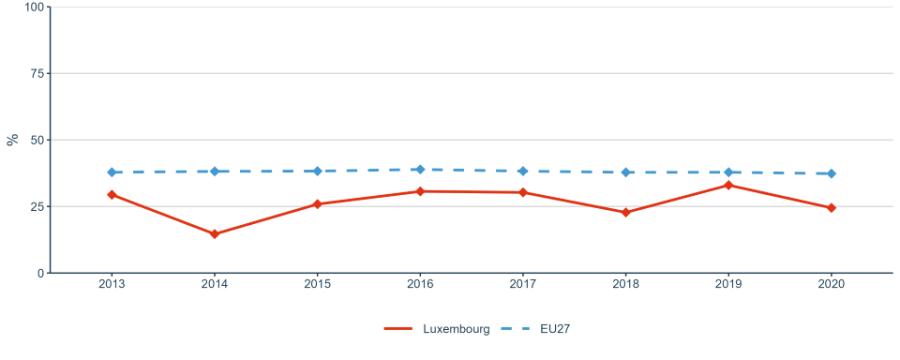
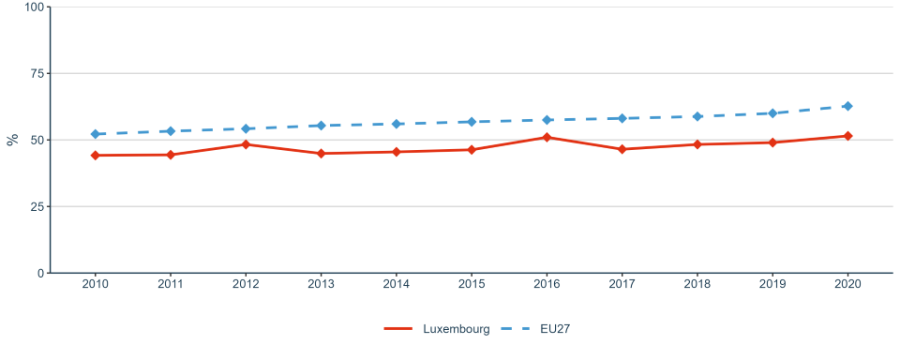


Sub-priority 1.4: Researchers’ careers and mobility and research assessment and reward systems
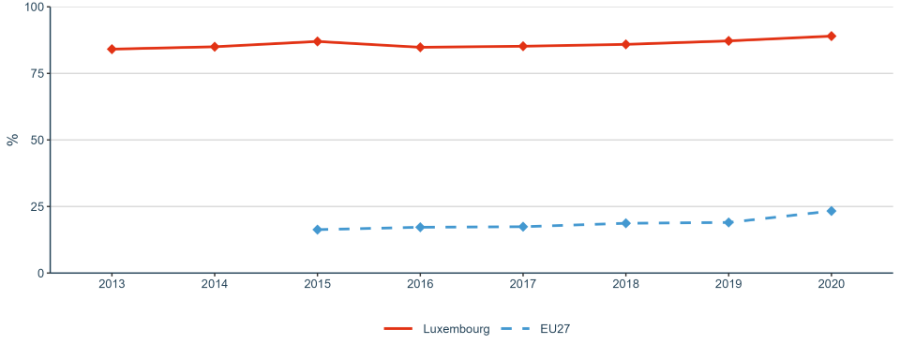


Sub-priority 1.5: Knowledge valorisation

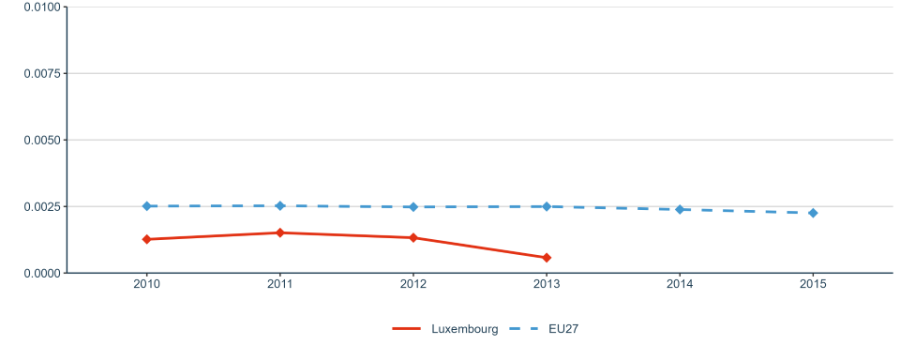
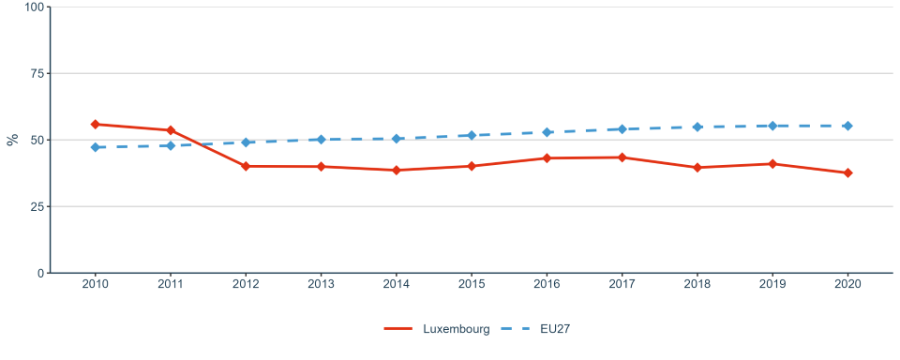


Sub-priority 1.6: Scientific leadership


Sub-priority 1.7: Global engagement
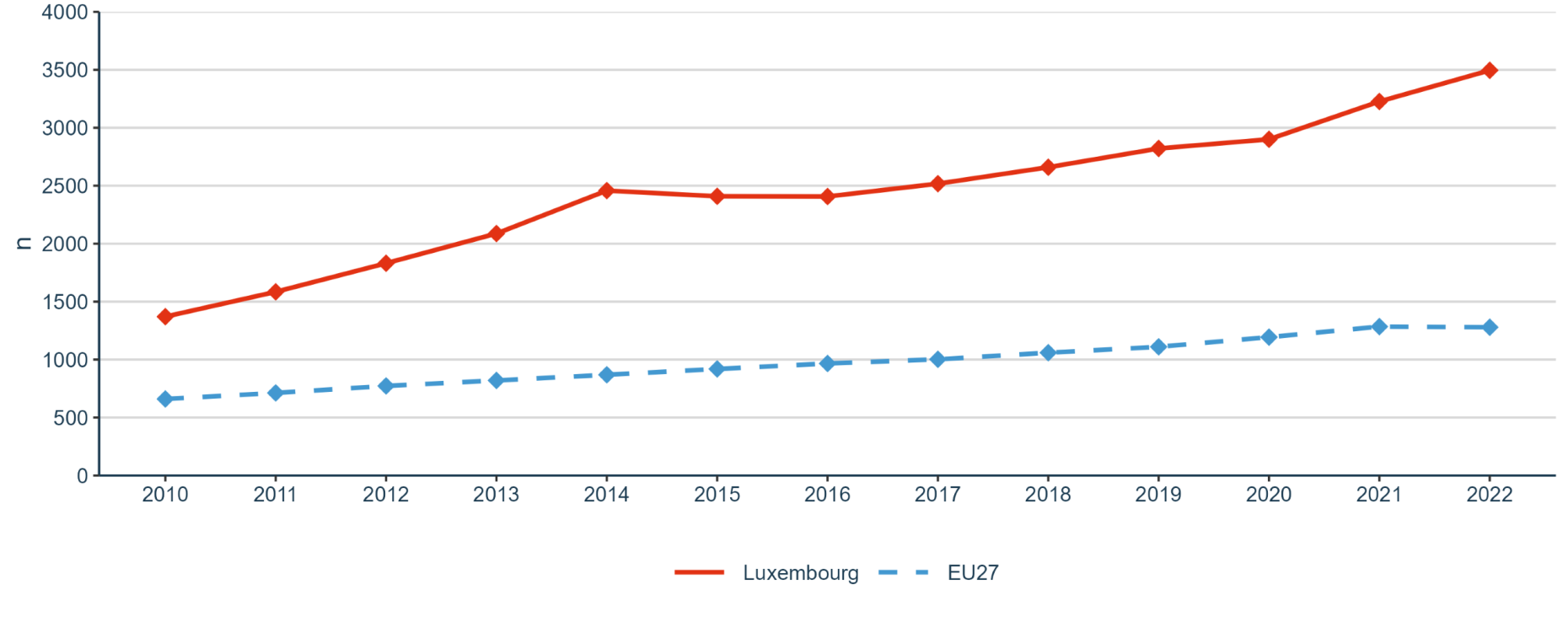
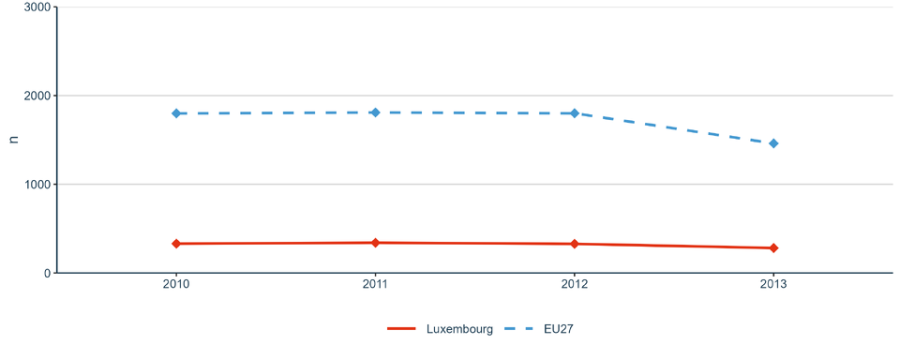
Priority 2: Taking up together the challenges posed by the twin green and digital transition, and increasing society’s participation in the ERA
Sub-priority 2.1: Challenge-based ERA actions

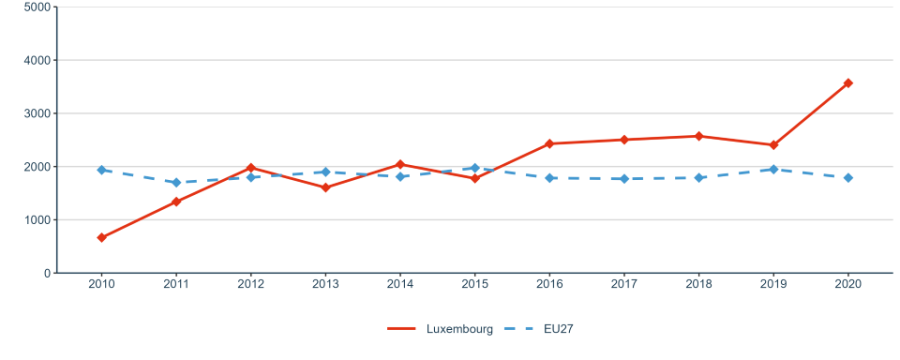
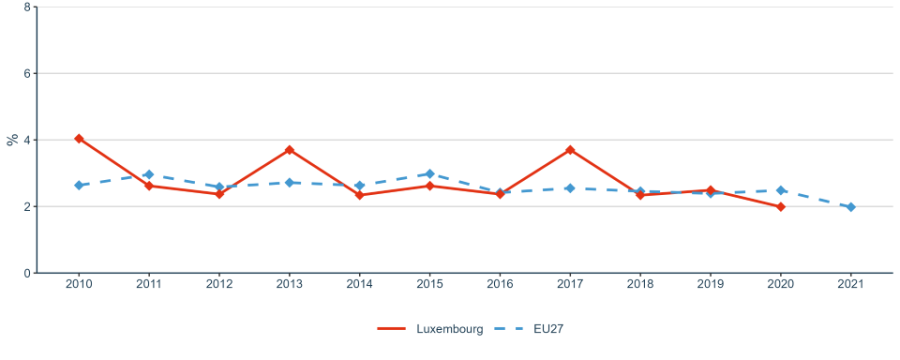


Sub-priority 2.2: Synergies with education and the European Skills Agenda
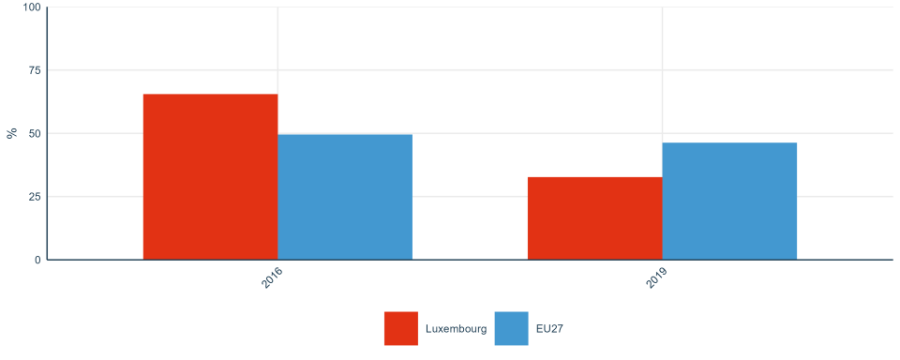
Sub-priority 2.3: Synergies with sectorial policies and industrial policy, in order to boost innovation ecosystems
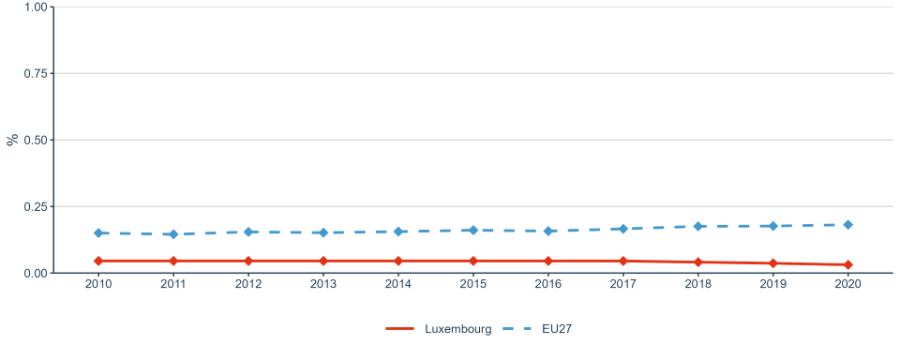
Sub-priority 2.4: An active citizen and societal engagement in R&I in all its dimensions


Priority 3: Enhancing access to research and innovation excellence across the Union
Sub-priority 3.1: More investments and reforms in countries and regions with lower R&I performance

Priority 4: Advancing concerted research and innovation investments and reforms
Sub-priority 4.1: Coordination of R&I investments

